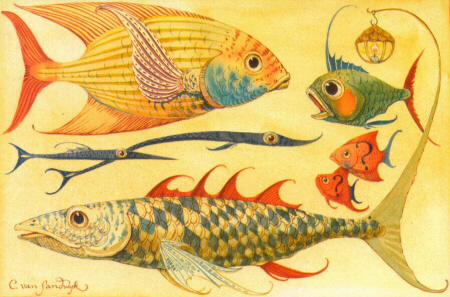
Perhaps they are more likely to be used as feed.Īmanda Schadeberg will investigate this together with her colleagues at Wageningen University and 18 other European research institutions and industry partners during the four year EU H2020 MEESO research project. Furthermore, lantern fish are small (5 to 15 centimeters), soft and greasy, so the question is how they can be used as food. For instance, lantern fish swim much deeper than fishermen normally fish and they don’t swim in schools, so they are more difficult to catch. Lantern fish is currently not commercially exploited, but it’s one of the key species among the organisms living in the deep sea, the so-called mesopelagic organisms, which represent the largest unexploited resource left in the world's oceans.īut as PhD Student Amanda Schadeberg, Wageningen University, points out in the article, there are some hurdles to overcome if lantern fish are to be caught commercially. Could jelly fish or lantern fish be commonly consumed instead of some of more well-known but often heavily exploited fish species? "How do we manage them properly if we're not able to count them properly? If you start tapping into that resource is it a good idea? More research needs to be done.An article in the Dutch magazine Vrij Nederland challenge the concept of edible seafood.

The trouble is, said Geoffroy, without knowing the biomass of lantern fish, a commercial fishery could present risks to the species itself and its predators. "Think about it - it's one of the last stocks that is not exploited and it's probably the most abundant, so it would be really surprising that there would not be projects, at least in the future, to see if it could be exploited." said Geoffroy. As nouns the difference between lanternfish and lionfish is that lanternfish is any of small, deep sea fish of the large family myctophidae, named after their conspicuous use of bioluminescence while lionfish is any of the venomous fish of the scorpaenidae family, notable for their long and separated spines. Geoffroy said there are also pilot studies underway in Norway to explore using lantern fish protein as feed for farmed salmon in the aquaculture industry.Ĭurrently, there is no commercial fishery in Canada for lantern fish, but Geoffroy said it could be on the horizon. The fish contain a lot of wax, so harvesters in the Gulf of Oman and Southern Africa sell their catch for use in the cosmetics industry. There are only a few places in the world where there is a commercial fishery for lantern fish. So they are not just important for the predators, but also for the climate and to help us cope with our increase in CO2," said Geoffroy. "By descending at great depths … they go and eject fecal pellets at depth during the daytime. So that's one hint that it's probably a reaction to predation or to fear.… The bioluminescence is being used to camouflage so their predators have trouble seeing them," said Geoffroy. "We know they produce light when they are stressed. The fish might be communicating with each other to signal danger lurking in the depths, he said. John's, the reasons are not fully understood.

Phillips of Philadelphia, who collected many of the local fishes for Fowler. (Jane Adey/CBC) Lantern fish may be tiny just four to five centimetres in length but what this deep ocean swimmer lacks in individual size, it makes up for in number. The fish is named in honor of the late Dr. This species reaches a length of 7.7 cm (3.0 in). In this twilight zone, there's very little light - less than one per cent of the light at the water's surface - but not complete blackness.īut why do lantern fish light up? According to Maxime Geoffroy, a fisheries researcher scientist at the Marine Institute in St. Diaphus phillipsi, the Bolin's lantern fish, is a species of lanternfish found in the Indo-Pacific. Lantern fish are mesopelagic, meaning they live between 200 and 1,000 below the water's surface.

The same way fireflies glow on land, lantern fish can glow underwater, an effect called bioluminescence.

Way down in a spooky part of the ocean called the twilight zone lives the lantern fish.Īptly named, this flashy fish emits its own light lantern fish have organs on their bodies, called photophores, that produce a molecule called luciferin that, when combined with oxygen, makes a blue-green light. (Submitted by Eugenie Jacobsen - image credit) Glacier lantern fish, or benthosema glaciale, are the most common lantern fish in the waters off Newfoundland and Labrador.


 0 kommentar(er)
0 kommentar(er)
